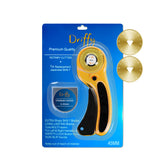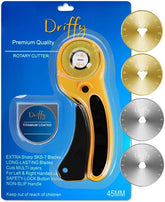Rotary Cutter Blades 45mm for Fabric
Introduction to rotary cutter blades
Rotary cutter blades are a key component of any sewing or crafting project that involves cutting fabric or other materials. These blades are designed to be used with rotary cutters, which are hand-held cutting tools that can cut through multiple layers of fabric quickly and precisely.
There are different sizes of rotary cutter blades available, with 45mm being the most commonly used size. Other blade sizes include 28mm, 60mm, and 18mm, each suited for different types of projects.
In addition to different sizes, there are also different types of rotary cutter blades available, such as straight blades, curved blades, and specialty blades designed for cutting specific materials like leather or foam.
Overall, rotary cutter blades are a versatile and essential tool for anyone who enjoys sewing, quilting, or crafting. By understanding the different sizes and types of rotary cutter blades, you can choose the right blade for your project and achieve precise and efficient cutting results.
Benefits of 45mm rotary cutter blades
There are many benefits to using a 45mm rotary cutter blade for cutting fabric and other materials. Here are some of the key advantages:
- Versatility: 45mm rotary cutter blades are the most commonly used size, making them easy to find and compatible with most rotary cutters. This makes them a versatile option for general cutting needs.
- Precision: 45mm rotary cutter blades are designed to cut through multiple layers of fabric quickly and precisely. This makes them ideal for projects that require precise cuts, such as quilting or pattern making.
- Efficiency: The 45mm size is a good balance between speed and accuracy, allowing you to cut through fabric quickly without sacrificing precision. This can help you complete your projects faster and with less effort.
- Smooth cutting: 45mm rotary cutter blades are sharp and designed to cut smoothly through fabric, resulting in clean and precise cuts.
- Cost-effective: Because 45mm rotary cutter blades are a commonly used size, they are often more affordable than larger or specialty blades.
Overall, the 45mm rotary cutter blade is a versatile and reliable tool for cutting fabric and other materials. Its precision, efficiency, and smooth cutting ability make it a popular choice among sewing and crafting enthusiasts.
Different types of 45mm rotary cutter blades
There are different types of 45mm rotary cutter blades available, each with unique features that make them suited for specific cutting needs. Here is an overview of some of the different types:
- Straight blades: Straight blades are the most common type of 45mm rotary cutter blade. They are versatile and can cut through most types of fabric and other materials.
- Curved blades: Curved blades are designed for cutting curved lines and shapes, making them a great option for quilting and pattern making. The curve allows for smoother and more accurate cutting along curves.
- Pinking blades: Pinking blades are designed to create a zig-zag edge on fabric, which can prevent fraying and provide a decorative finish. They are a great option for finishing seams on clothing or other fabric projects.
- Wavy blades: Wavy blades are similar to pinking blades, but instead of creating a zig-zag edge, they create a wavy edge. They can be used for decorative purposes or to prevent fraying on fabric edges.
- Specialty blades: There are also specialty blades available for cutting specific types of materials, such as leather or foam. These blades have a unique design that allows them to cut through these materials efficiently and effectively.
When choosing a 45mm rotary cutter blade, consider the type of material you will be cutting and the type of cut you need to make. A straight blade may be sufficient for most projects, but a curved blade or specialty blade may be necessary for more intricate or specific cutting needs.
Choosing the right blade for your project
When choosing the right blade for your project, it's important to consider a few factors that will affect the outcome of your cutting. Here are some tips and advice on how to choose the right blade for your specific project:
- Type of material: Different types of materials require different types of blades. For example, a straight blade may work well for cutting through cotton fabric, but may not be suitable for cutting through thick materials like denim or leather. Make sure to choose a blade that is designed for the type of material you will be cutting.
- Level of detail: If your project requires intricate or detailed cutting, a smaller blade size like 28mm may be more suitable. Smaller blades are better for cutting tight curves and intricate shapes. If you are cutting straight lines or larger pieces of fabric, a larger blade like 45mm may be more efficient.
- Budget: Blades come in a range of prices, with some specialty blades costing more than standard blades. Consider your budget when choosing a blade for your project.
- Type of cut: Consider the type of cut you need to make. For example, if you need to make a zig-zag or wavy cut, a pinking or wavy blade may be more suitable. If you need to cut along a curved line, a curved blade may be necessary.
- Brand compatibility: Make sure to choose a blade that is compatible with your rotary cutter. Different brands may have different blade sizes and designs that are not compatible with other brands.
By considering these factors, you can choose the right blade for your specific project and achieve the desired cutting results. It's important to remember to always follow safety precautions and properly maintain your blade for longevity and effectiveness.
Changing the blade
Here is a step-by-step guide on how to change a 45mm rotary cutter blade, following the manufacturer's instructions:
- Check the manufacturer's instructions: Before attempting to change the blade, make sure to check the manufacturer's instructions for your specific rotary cutter. Each rotary cutter may have a slightly different mechanism for changing the blade.
- Remove the old blade: To remove the old blade, first, disassemble the rotary cutter according to the manufacturer's instructions. Then, locate the button or release mechanism that holds the blade in place. Press the button or release mechanism and carefully remove the blade.
- Prepare the new blade: Unpack the new blade and make sure it is the correct size and type for your rotary cutter. Make sure to handle the blade carefully as it will be sharp. Most blades have a small hole in the center where it will attach to the rotary cutter.
- Attach the new blade: Insert the new blade into the blade holder, making sure the hole in the blade lines up with the pin in the blade holder. Gently press down on the blade until it snaps into place. Make sure the blade is securely attached.
- Reassemble the rotary cutter: Once the new blade is attached, reassemble the rotary cutter according to the manufacturer's instructions. Make sure all parts are securely in place.
- Dispose of the old blade: To dispose of the old blade, wrap it in newspaper or other protective material before placing it in the trash. Do not touch the sharp edges with your bare hands.
By following these steps and the manufacturer's instructions, you can safely and effectively change the blade on your 45mm rotary cutter. Always handle the blade with care and make sure it is securely attached before using the rotary cutter.
Maintaining and caring for 45mm rotary cutter blades
Proper maintenance and care of your 45mm rotary cutter blade can extend its lifespan and ensure that it is working effectively. Here are some tips and advice on how to care for and maintain your 45mm rotary cutter blade:
- Keep it clean: Regularly cleaning your blade can help prevent build-up of debris that can dull the blade over time. Use a soft, dry cloth or a brush to remove any dust or debris from the blade after each use.
- Use a honing stone or strop: A honing stone or strop can be used to sharpen the blade and extend its lifespan. Follow the manufacturer's instructions for using a honing stone or strop to ensure safe and effective use.
- Replace the blade when necessary: A dull or damaged blade can result in uneven or poor quality cuts. Replace the blade when you notice it becoming dull or damaged, or if it is no longer cutting effectively.
- Store the blade properly: When not in use, store your rotary cutter with the blade covered or removed to prevent accidental cuts and to protect the blade from damage.
- Follow manufacturer's instructions: Always follow the manufacturer's instructions for your specific rotary cutter and blade when cleaning and maintaining them.
By properly maintaining and caring for your 45mm rotary cutter blade, you can ensure that it is working effectively and producing high-quality cuts. Regular cleaning, use of a honing stone or strop, timely replacement of the blade, and proper storage can all help extend the lifespan of your blade and keep it working effectively for your sewing and crafting projects.
Troubleshooting common issues
Here are some common issues that may arise when using a 45mm rotary cutter blade and their potential solutions:
- Dullness: Over time, your rotary cutter blade may become dull, resulting in uneven or poor quality cuts. To resolve this issue, you can try sharpening the blade using a honing stone or strop, or replace the blade if it is too dull to sharpen.
- Skipping: Skipping occurs when the blade does not cut through the material smoothly and jumps or skips over certain areas. This may be due to a dull blade, improper pressure, or using the wrong blade for the material. To resolve this issue, make sure to use the appropriate blade for the material, apply even pressure, and sharpen or replace the blade as necessary.
- Wobbling: Wobbling occurs when the blade moves from side to side, resulting in uneven cuts. This may be due to a loose blade or blade holder. To resolve this issue, check that the blade and blade holder are properly secured, and tighten any loose screws if necessary.
- Inaccurate cuts: Inaccurate cuts can occur when the blade is not aligned properly, or if the rotary cutter is not held steady. To resolve this issue, make sure to hold the rotary cutter steady and follow the cutting line precisely, and check that the blade is properly aligned with the guide markings on the rotary cutter.
By addressing these common issues, you can ensure that your 45mm rotary cutter blade is working effectively and producing high-quality cuts. Regular maintenance, proper use, and use of the appropriate blade for the material can help prevent these issues from occurring in the first place.
Creative uses for 45mm rotary cutter blades
In addition to their primary function of cutting fabric and other materials, 45mm rotary cutter blades can also be used creatively in various sewing, quilting, and crafting projects. Here are some creative and unique ways to use 45mm rotary cutter blades:
- Paper cutting: 45mm rotary cutter blades can be used to cut paper for scrapbooking, card making, and other paper crafting projects. They are a quick and efficient way to cut straight lines, curves, and shapes out of paper.
- Stencilling: 45mm rotary cutter blades can be used to create stencils for painting and other art projects. Simply cut out the desired shape or design from a sheet of acetate or other stencil material using the rotary cutter and use the resulting stencil to create your design.
- Appliqué: 45mm rotary cutter blades can be used to create precise and intricate shapes for appliqué projects. Use the rotary cutter to cut out fabric pieces and then sew them onto a base fabric for a unique and personalized look.
- Fabric weaving: 45mm rotary cutter blades can be used to create strips of fabric that can be woven together to make unique and creative fabric projects such as baskets, mats, and coasters.
- Ribbon cutting: 45mm rotary cutter blades can be used to cut ribbon for various sewing and crafting projects, including bows, hair accessories, and decorations.
By thinking creatively and using 45mm rotary cutter blades in unexpected ways, you can add unique and personalized touches to your sewing, quilting, and crafting projects. Just remember to always use proper safety precautions and follow manufacturer's instructions for your rotary cutter and blade.
Frequently asked questions
Here are some frequently asked questions about 45mm rotary cutter blades, along with expert answers and advice:
- What is a 45mm rotary cutter blade and how does it work? A 45mm rotary cutter blade is a circular blade that is attached to a rotary cutter and used for cutting fabric, paper, and other materials. The blade rotates as you push the rotary cutter along the material, allowing for precise and efficient cutting.
- How often should I change my 45mm rotary cutter blade? The frequency of blade changes will depend on how often you use your rotary cutter and the type of material you are cutting. As a general rule of thumb, it is recommended to change the blade every few months or when it starts to feel dull.
- Can I sharpen my 45mm rotary cutter blade? Yes, 45mm rotary cutter blades can be sharpened using a honing stone or strop. Follow the manufacturer's instructions for your specific blade and honing tool.
- Can I use a 45mm rotary cutter blade for cutting leather or other thick materials? While 45mm rotary cutter blades are designed for cutting fabric and paper, they may not be suitable for cutting thicker materials like leather or foam. Check the manufacturer's instructions for your specific rotary cutter and blade to ensure compatibility with thicker materials.
- How do I properly maintain and care for my 45mm rotary cutter blade? To properly maintain and care for your 45mm rotary cutter blade, keep it clean and free of debris, store it properly when not in use, use a honing stone or strop to sharpen it as necessary, and replace it when it becomes dull or damaged.
- Can I use a 45mm rotary cutter blade for left-handed cutting? Yes, 45mm rotary cutter blades can be used for both right- and left-handed cutting. However, make sure to choose a rotary cutter with an ambidextrous design for comfortable use by both right- and left-handed users.
By understanding these frequently asked questions and their answers, you can ensure that you are using your 45mm rotary cutter blade effectively and safely for your sewing and crafting projects.












Leave a comment
Please note, comments need to be approved before they are published.